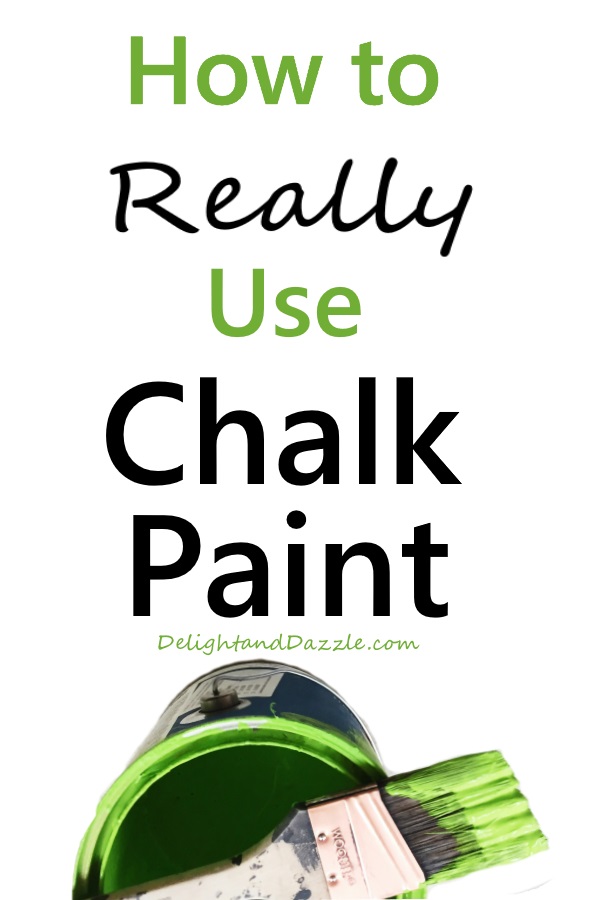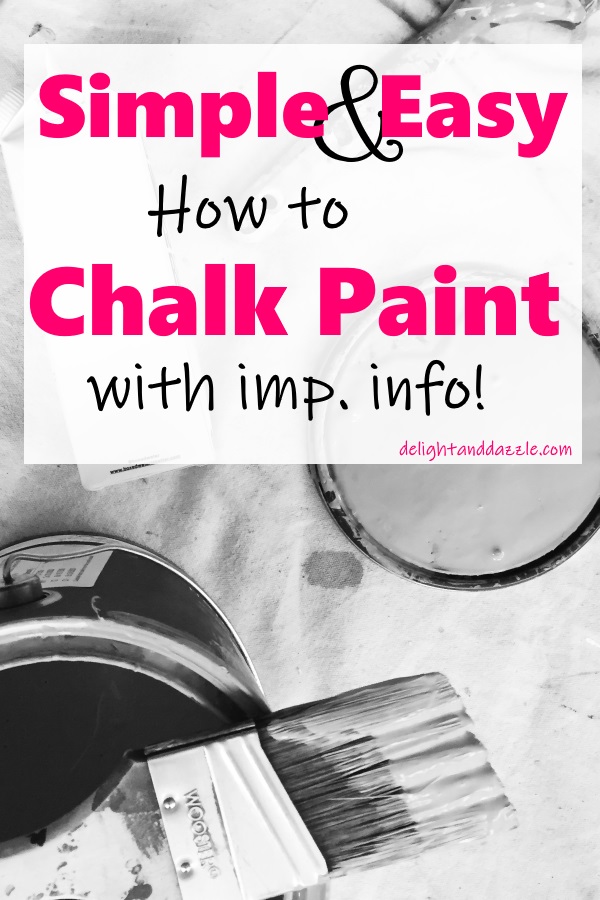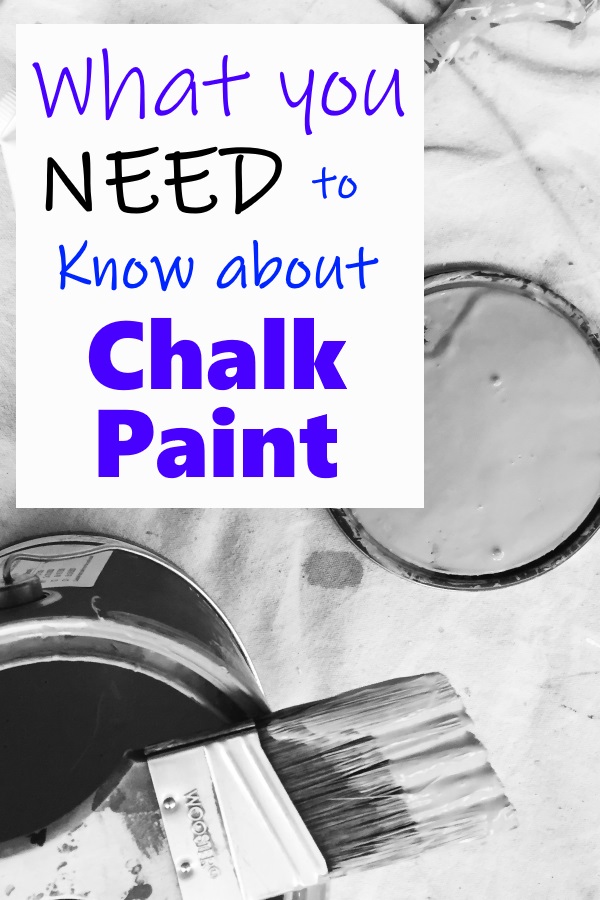How To Chalk Paint Furniture And Chalk Paint Recipes
I’m going to show you how to chalk paint furniture in a very easy, simple way. Painting with chalk paint is easier and simpler than painting with regular paint since the furniture you are painting requires very little prep and the dry time is incredibly fast.
These steps for how to chalk paint furniture are the same for any type of chalk paint you use from Annie Sloan to a DIY recipe. You can chalk paint just about anything from wood to laminate to material (no joke!! But whether or not you want to paint the upholstered fabric is another thing). However, I have heard that you don’t want to paint your kitchen or dining table with chalk paint without a really good top coat. Not even my wood table that isn’t painted can withstand my kiddos. It has fork dings in it everywhere.
Again, Annie Sloan is the premium chalk paint line and you can check it out here …
If you have Annie Sloan chalk paint already, or another pre-mixed chalk paint, then skip below to the ‘How to chalk paint furniture’ steps below. If not, keep reading to make your own.

DIY Chalk Paint Recipe
I have been using my own chalk paint recipe for years and it has worked great. Annie Sloan has a beautiful line of colors and great quality paint. However, when I got into using chalk paint there were a couple of problems. First, I couldn’t find a retailer selling Annie Sloan anywhere near me back then (nowadays you can find other branded chalk paint on Amazon). Second, I was already reluctant to pay the expensive price for the paint (plus more for shipping). I just wasn’t willing to pay the high price for testing out how to chalk paint furniture.
I did a LOT of research and found a good way to make it myself for a fraction of the cost. It has worked so well that I haven’t found a need to pay more money for anything different. I have used this recipe on multiple pieces of furniture and haven’t regretted it.
Chalk Paint Recipe With Plaster Of Paris
- 1 Tbsp. Plaster of Paris
- ¼ cup water
- Mix really well then add 1 cup regular latex paint
You may also find a recipe with different ratios
- ⅓ cup Plaster of Paris
- ⅓ cup water
- Mix really well then add 1 cup regular latex paint
Either recipe will work but I have found the more water the better. I even sometimes “eye it” without measuring so don’t worry about being exact, if you don’t want to put paint in your kitchen measuring cups. With a little more water your paint will go on easier and it won’t dry quite as fast. Warm water instead of cold may dissolve the powder better but either one works.
Mix it well but a spoon or stick will work. Some say they use a blender … I don’t want to put paint in my blender and I’m not buying a blender just for mixing my paint. If you’re concerned about getting the paint just so for your first or second project then by all means, measure it out and use a good hand mixer tool. Add a little bit of water and mix well if the paint isn’t going on the piece of furniture smoothly. If it still seems too thick then add a little more water. It’s also okay if your first coat doesn’t look great because your second coat will look nicer.
Chalk Paint Recipe With Calcium Carbonate
I’ve also heard a lot of people love using calcium carbonate instead of Plaster of Paris. The calcium carbonate is non-toxic!
- 4 Tbs Calcium Carbonate
- 2 Tbs water
- Mix really well then add 1 cup paint
Each of these chalk paint recipes will give you enough paint for a medium-size piece of furniture.
Picking Out Paint For Your Chalk Paint Recipe
You can choose any color of paint when you are mixing it yourself. At Home Depot I pay around $2 for a sample size (which happens to be 8 oz or 1 cup). That amount is good for two coats on a small or medium-sized piece of furniture. You’ll want regular latex (water-based) paint with a flat sheen (no gloss). I don’t think it will hurt to have gloss, I’ve used gloss before, but adding the powder will make it flat.
Which Brush To Use And How To Get A Smooth Finish
Use a good brush. If you’re planning to do many projects than maybe you’ll want to buy a more expensive brush that’s supposed to last longer. The brush that I linked to in the material resources list below is a pretty good brush and reasonably priced.
As you are painting and you need to stop in between coats or you need to leave momentarily, wrapping your brush in saran wrap will keep the paint on your brush from drying and hardening. You want to be able to clean the paint out from your brush and the bristles well so that the brush will stay in good condition for the next project. If, on the next project, you find the bristle ends on your paint brush aren’t soft and smooth, that could affect how smooth the coat of paint goes on IF you want the smooth finish with no brush marks. You want soft bristle ends.
Being sure to add a little water if your paint gets too thick makes a difference (see my note above about adding water).
Those are good tips, but possibly the best tip that will make the biggest difference for getting a smooth finish with no brush strokes, is sanding in between your coats of paint and after your last coat of paint. If you use a primer you’ll want to sand after the primer as well. Chalk paint won’t cover up something that isn’t smooth.
Get 220 grit (extra fine!) sandpaper and sand by hand until you get that smooth finish you are going for. You can use an electric sander but be careful not to sand too much or you’ll be painting your coat over again.
Material Resources for Chalk Painting Furniture
- Plaster of Paris
- Calcium carbonate
- A good paint brush
- Pre-Made Chalk Paint
- Primer- regular shellac, spray shellac or try Boss by Dixie Belle (great stuff!)
- Wax
- Wax Brush
- Polyurethane Protective Seal Coat in Matte Finish
- This stuff by Dixie Belle is awesome! It’s a clear finish that isn’t wax but won’t yellow your white paint. This one here is more heavy duty with a waterproof finish.
- 220 Grit Sand Paper
- Frog Tape that keeps the paint from the edges where you don’t want it, and is easy to peel off when you are finished.
- Elmer’s Wood Filler – I didn’t talk about this at all but if you are taking off the old hardware and using new hardware that need different holes on your dresser or furniture, this makes it easy to fill the old holes. The instructions on the tube are easy to follow. I love this stuff! Just sand smooth with the 220 grit sand paper.
Save THIS Pin below to your Pinterest Chalk Paint Furniture board for later!

How To Chalk Paint Furniture- Simple and Easy
Step 1 Remove Hardware
Step 1 Prep Your Piece of Furniture
For any surface you should give it a quick wipe down with soapy water. Dish soap, warm water, and a rag. Usually that’s it and you don’t need to prep more. However there are exceptions- see below. If your furniture seems oily at all (like New IKEA furniture) or any other grime that the soapy water doesn’t remove it for some reason, try removing it with mineral spirits.
Psst! No Sanding Required
I love that you don’t have to sand your wood furniture before painting with chalk paint. That might be the best perk. So much time and effort saved! When I began trying out chalk paint I was a little nervous about not sanding first, even though others said it was okay. It really is okay. One piece of furniture I’ve had for almost six years and no problemo yet. I even have kids who pull the drawers of my hutch in and out (I keep the kids’ games in the drawers), throw blocks at it, and traffic in and out of the front room goes right by it, so it’s in the line of fire and still looks great.
However, you may be doing some sanding- in between coats of paint (and primer if you’re priming) IF you want the professionally smooth look that has no brush marks. Without sanding you will see light brush marks if you look closely. From a normal distance it will seem smooth. I like this look so I don’t sand.
When You Need To Prep With A Primer
Cherry or mahogany wood can bleed through your paint. This is known as tanning staining. Tannins exist in some woods (more commonly redwood such as cherry or mahogany but also cedar) and it leaves a yellowish-brown stain on the surface, no matter how many coats you paint. If you aren’t sure if you have redwood (they are darker wood) then you can test paint it in a small area first.
Varnishes can also create problems such as giving a water-based poly seal coat on top a crackle affect. The worst thing that can happen after painting your project is then having one of these issues. But you still don’t have to sand! To eliminate these problems, seal it with a coat of shellac or other tannin blocking primer first and then use your chalk paint. That will prevent bleeding and crackling.
This is a great article with more information on how to test bleed-through and more detail if you do have bleed-through.
When You Do Want To Sand First
If you have laminate or another shiny and slick surface such as metal then you’ll want to roughly sand first. Don’t go crazy, just enough to scruff up the surface. See this guide for painting over laminate. You’ll also see what happens if you skip this important step.
Step 3 Tape
Tape if needed (any edges where you don’t want paint to go).
Step 4 Paint
Paint fairly quick and with long, sweeping strokes. Dip your brush (just barely) in water before dipping in the paint if you find the paint getting a little too thick. The paint dries fast enough that by the time you finish the first coat over the whole project you will likely be able to start on the second coat where you first started. With Annie Sloan or a pre-mixed chalk paint you might need to wait a touch longer. Wrap your paintbrush in saran wrap or in a ziplock bag to keep it from drying out if you have to stop painting.
Usually you only need two coats. If you’re painting with white on a darker piece you might want to go with a third coat. That’s it! Not a whole lot to it and very simple.
Step 5 (Optional) Sand or Distress
If you feel the paint on your furniture is rough to the touch after the coats have dried, feel free to get 220 grit sand paper and lightly sand over the furniture piece. I haven’t ever felt the need. This is also the time to distress your furniture if you want a distress look.
Sept 6 Seal With Wax Or Poly
If you don’t seal your piece of furniture after painting with chalk paint, it will look chalky and dry over time. I tried this one time. I have a piece of furniture that I sealed only partly in a few places with polyurethane. A couple of years later I went back and finished sealing it with wax (where I didn’t have the poly coat). Silly, I know, but now I can tell you the differences the finishes all make.
Just a quick note about that. You cannot put a polyurethane coat over wax. The wax will repel it. You can remove the wax with something like mineral spirits and then put on a different finish for your project. You can put a wax coat over polyurethane.
Wax
Wax takes 21 days to fully cure and after a couple of years you are supposed to wax again since wax is not permanent. Applying wax takes a little practice (just a little) to figure out. You can use a white, soft rag or a brush. I find a brush much easier and it helps when you are first trying to figure it out. A little wax goes a long way
You don’t need any particular type of brush but one with stiff bristles. Brush on the wax and then go behind and wipe clean with a cloth until it is smooth and doesn’t feel sticky anymore. Work in sections if you are working on a large surface area. Clean your brush with soap.
To apply the wax with a cloth instead of a brush you will rub the wax in until it doesn’t feel sticky anymore. Rags get wax build-up fast and then you have to switch it out. After you’ve waxed the entire piece of furniture, wait about 15 minutes and then go back and buff. To buff, get a clean cloth or steel wool and rub in a gentle,circular motion across the furniture’s surface.
Polyurethane
I prefer polyurethane. Once it is applied the piece is finished and I don’t have to think about adding another coat years later. For some reason, I always dread the thought of having to re-visit a project I’ve already completed. It isn’t exciting like a new project. Wax does give a nice deep sheen but the end result is pretty close. On the wood furniture I mentioned earlier where I did some in polyurethane and some in wax, I can’t even tell the difference.
You can get a gloss clear coat. I like the matte clear coat but it’s a touch harder to find in stores. It will dry clear. I don’t paint a lot with white but a regular poly coat will turn your white paint a yellowish tint. This clear coat finish and this one have great reviews. It will not turn yellow on white paint. If you are using a color (that is not white) then any poly should work just fine.
Apply the poly coat with a brush or sponge, let dry, and then apply a second and maybe a third coat. Be careful not to over shake or over stir so you don’t get bubbles. It will look creamy until it is dry and then it really will be clear.
Step 7 Add Hardware
Add your hardware back on and appreciate your handiwork!

Wrap Up
This is the simple, easy way how to chalk paint furniture. It’s excellent for DIY and will give you beautiful results.

Leave a Reply